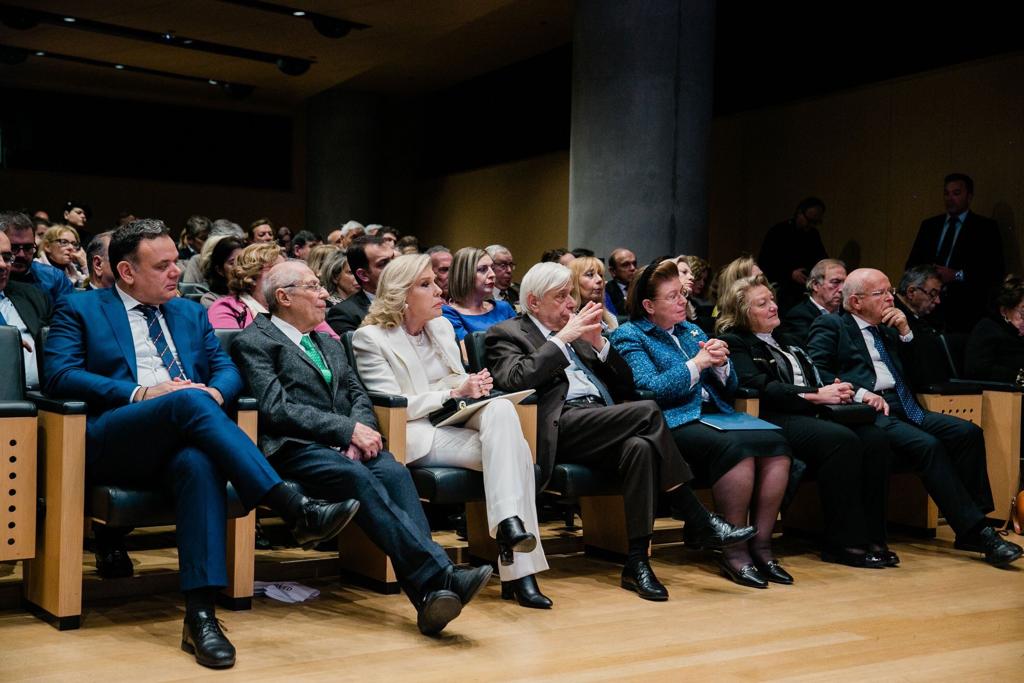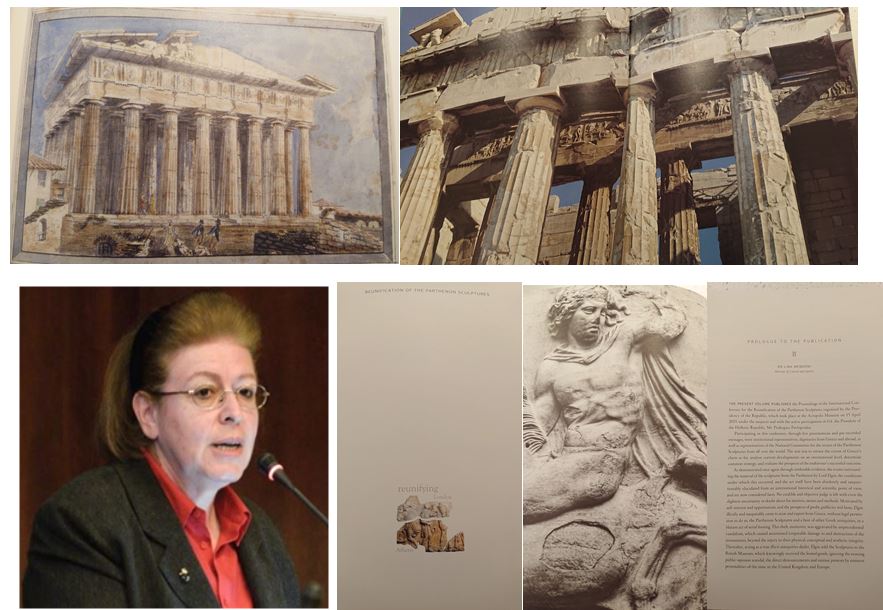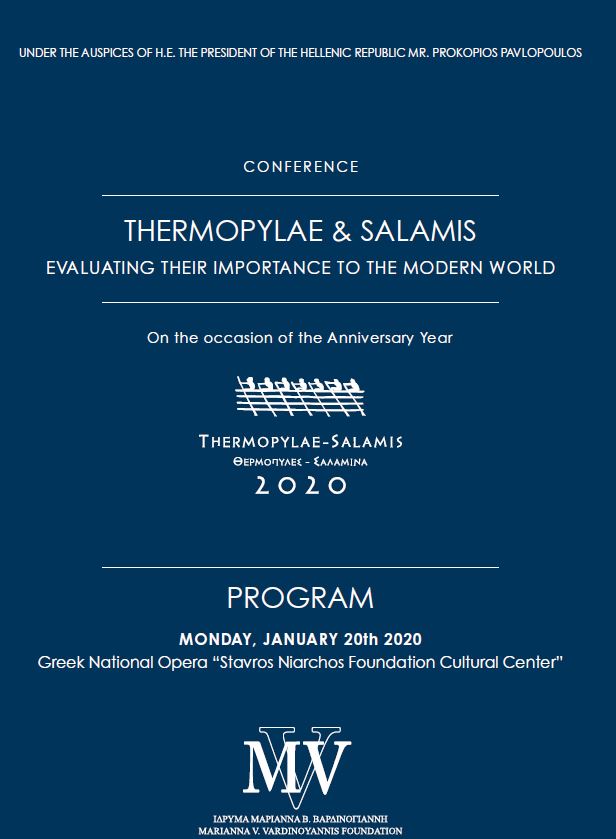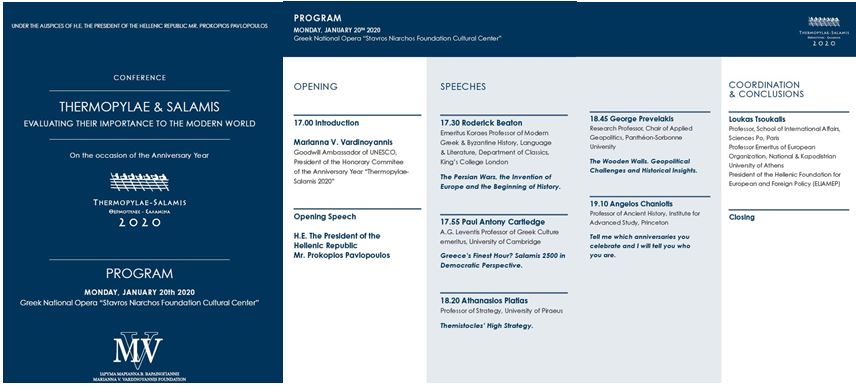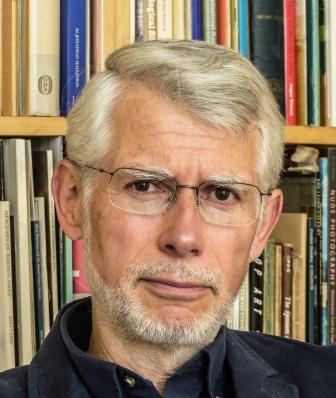words are transient, yet the written texts remain forever
Dr Christiane Tytgat, Chair of the IARPS
Wednesday 29 January 2020 at the Acropolis Museum, the launch of the published proceedings of the 15 April 2019 International Conference: 'The Reunification of the Parthenon Sculptures'. The conference was held under the auspices of the President of the Hellenic Republic, Prokopios Pavlopoulos. A number of campaigning committees attended and some also spoke at the conference, including Professor Louis Godart, Chair of the International Association for the Reunification of the Parthenon Sculptures (IARPS), Dame Janet Suzman as Chair of the BCRPM and Professor Paul Cartledge as Vice Chair of the BCRPM.
Both Professor Louis Godart as the Former Chair for the International Assciation and the current Chair Christiiane Tytgat, spoke at the event held on the 29th of January this year and their respective speeches can be read below.
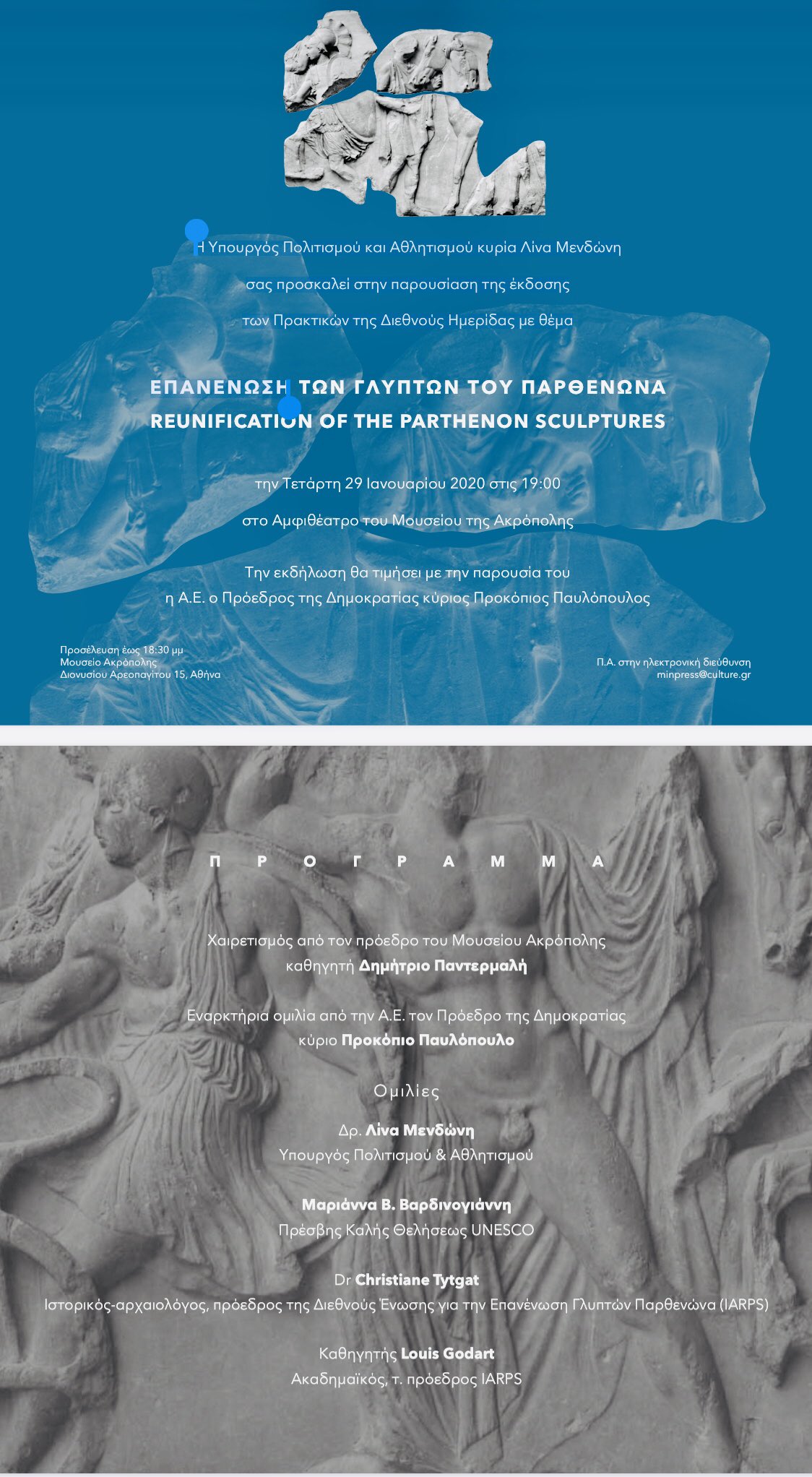
Chair of the International Association, Christiane Tytgat's address:
President of the International Association, Dr Christiane Tytgat's address at the launch of the Proceedings of the International Conference on the Reunification of the Parthenon Sculptures, held at the Acropolis Museum on April 15, 2019:
Your Excellency, Mr President, Your Excellency, Madam Minister, Dear Friends and Colleagues, Ladies and Gentlemen, first of all I would like to thank His Excellency, the President of the Hellenic Republic, Mr Pavlopoulos, the Minister of Culture and Sports, Dr Mendoni and the President of the Acropolis Museum, Professor Pantermalis for the honour of inviting me to be here with you today.
It is a great pleasure to be here again, in this wonderful Museum which celebrated its 10th anniversary last year with a series of events. Among these events, the key event was the opening of the archaeological excavation beneath the museum on the 20th of June 2019. Hence the Museum adds again an element to its precious wealth and shows, once again, that it is a museum always in motion, a museum that offers continually something new to its visitors. I wonder, how many other museums can say this without organising a temporary exhibition and bringing artefacts from elsewhere? Increasingly the Acropolis Museum evokes the image of the sacred rock: the Parthenon Room, at the top of the Acropolis Museum, which is waiting for more than 10 years to be completed, now dominates an ancient neighbourhood of Athens, as in ancient times the Acropolis was dominating the ancient city.
The conference "Reunification of the Parthenon Sculptures" was part of these anniversary festivities. I would add that after 10 years of the Museum's operation, it is a pity that we still have to hold another conference on this subject, however we can look at this in a positive way too. Many speakers from Greece, but also from all over the world made the journey to participate in the conference and show their interest in the issue of reunification. Each intervention embraced the issue from a different perspective, from the results of recent research and proposals for a solution to actions to keep the case in the news until we achieve our goal. The conference was resounding in its message, delivered so eloquently by so many speakers.
But "words are transient, yet the written texts remain forever". That is why it is very important that the Proceedings of the conference were published. There is also no better time to present them, since today begins the Year of Melina Mercouri, the great protagonist for the return of the Sculptures. We cannot honour her in a better way: her campaign for the return of the Parthenon Sculptures from the British Museum continues and her vision is more alive than ever.
Melina's campaign is no longer the struggle of any one person or the Hellenic Government who made the first request to the British Museum for the return in 1842. The struggle was transferred - and rightly so - globally, since the Parthenon and its Sculptures are a world cultural heritage.
In 1981, the first Committee was established in Australia, headed up by its President Emanuel Comino. It remains very active to this day. Following Melina's passionate appeal to UNESCO in 1982, the British Committee for the Reunification of the Parthenon Marbles was founded in 1983. This was followed by the formation of many more committees worldwide.
At a conference organized in November 2005 by the Hellenic Government, 12 national committees established the International Association for the Reunification of Parthenon Sculptures (IARPS) with the aim of supporting the Hellenic Government in its repatriation efforts and the reunification of all the surviving parts of the Sculptures in the new Acropolis Museum. Since then, other new national committees have joined the International Association, most recently France (2016), Austria (2017), and - as strange as it may seem - the oldest committee from Australia (2018). In January 2020 we were delighted to also welcome the new Luxembourg committee.
Today, the IARPS has a total of 21 national committees spanning 19 countries. Every now and then a committee, like Russia in recent years, had fallen by the wayside but Moscow has given the committee a new impetus for the last six months and with great enthusiasm is organising its first lecture in February this year under the auspices of the Greek Ambassador in Moscow.
The IARPS works closely with the Greek authorities and supports the policy of cultural diplomacy, which Greece has been pursuing for years. The return of the Sculptures is a moral problem rather than a legal one. The International Association, which coordinates the activities of the national committees, observes that the public interest continues to grow, clearly illustrated by the continuously growing number of participants in our activities. The general climate helps us probably: the call for the repatriation of cultural heritage artefacts is global. There isn’t a day when a new article is not published and new activities are taking place. And in England, key voices grow louder too. Big museums are under pressure every day. So we are all optimistic that the time will come when theses museums will be able to do nothing less than return the stolen parts of the Parthenon to the place they rightfully belong: the Acropolis Museum in Athens, where one can see the sculptures by Pheidias on display in the best possible conditions, in direct visual contact with the Parthenon, where they are an integral part of. It would be a very happy coincidence if this would happen in 2021, the 200nd anniversary of the outbreak of the Greek War of Independence.
In conclusion, as Chair of the International Association and its 21 national Committees, I extend a very warm thank you to H.E. the President of the Hellenic Republic, Mr Pavlopoulos for his support over the years for the reunification of the Parthenon Sculptures.
To read more about the conference held on 15 April 2019, click here.
Professor Louis Godart, Former Chair of the International Association (2016-2019)
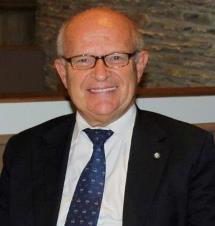
The stars in the skies of Attica and Greece saw the birth of Western Civilization, just as they saw the watchman above the palace of Mycenae catch the first evidence of the fall of Troy, and as they witnessed the enthusiasm of Pericles and of all the Athenians, when after 480 BC the city reinvented democracy, and rebuilt the monuments of Acropolis, the only place in the world where spirit and courage dwell together.
These are the very stars that also witnessed Elgin's assault when without any respect from 1801 to 1804 he violated the sanctity of the Parthenon, the temple, a global symbol of Democracy.
Inside the Acropolis Museum there is the stele of Mourning Athena. She is standing in front of another small stele. She is not wearing her aegis breastplate, her helmet doesn't cover her face. Her spear has its point on the base of the stele. What did the sculptor want to tell us when in about 460 BCE he carved this masterpiece?
Athena is the goddess of the intellect. She is also the goddess who is ready at all times for battle.
I believe that the stele bore the names of those Athenians who died at Marathon, Salamis and Plataea. Mourning Athena is showing the Athenians respect for those who saved Greece and Western Civilization. In our midst, the notion that Democracy must always be fought for is being honoured. We must always be ready, like the goddess, with our spear close to hand if we want to defend something of value and distinction.
So anyone who loves Greece and democracy - the Parthenon being as I said a symbol of Greece - must fight for the repatriation of Pheidias' sculptures.
I do not forget that in 1940 England - glory to the pilots of the RAF - saved European democracy. That Churchill said at the time: "Never in the field of human conflict was so much owed by so many to so few." England cannot today fail to heed the cry of everyone in the world who wants the sculptures to be near to the temple of the goddess. Today a lot of people in England are fighting alongside us. We will help them.
I hope that soon the stars of the heavens of Greece will again see the goddess' marbles beside the sacred rock.
